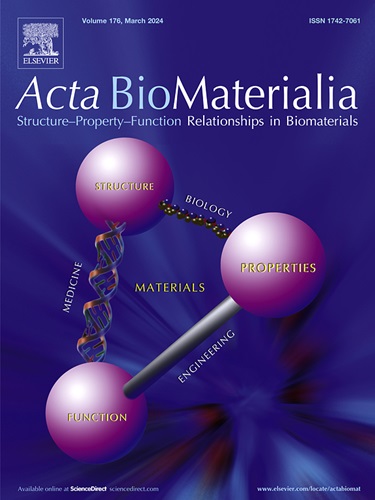Tailoring the dendronized structures of cyclodextrin-based supramolecular nanoassemblies for enhanced tumor paraptosis via disrupting endoplasmic reticulum homeostasis
IF 9.4
1区 医学
Q1 ENGINEERING, BIOMEDICAL
引用次数: 0
Abstract
Bioactive nanomaterials have been extensively utilized in medical applications. There are, however, very few reports on clinical applications of methylated β-cyclodextrin-derived supramolecular bioactive nanoagents, particularly in relation to the chemical features and biological properties. Herein, we designed and fabricated supramolecular bioactive nanoassemblies derived from permethyl β-cyclodextrin (PMCD) with increased proportions of PMCD on their dendronized side chains and further investigated the impact of chemical structures on their antitumor efficacy. Importantly, enhanced antitumor efficacy was observed with an increase in the proportion of PMCD on the dendronized side chains. Notably, pHPMA-co-(dendron Permethyl-β-CD4) (P4), which was featured with the highest PMCD proportion on its side chains, demonstrated the greatest potency in disrupting endoplasmic reticulum (ER) homeostasis, thus achieving conspicuous tumor cell paraptosis and promising antitumor efficacy in vivo without obvious side effects. Mechanistically, P4 colocalized with the ER, disrupted ER homeostasis, and triggered ER stress through the upregulation of proteins associated with the unfolded protein response, thus provoking abundant cytoplasmic vacuoles through the dilation of ER and resultant tumor paraptosis, a non-apoptotic mode of cell death. Overall, this study lays the groundwork for the precise design and synthesis of supramolecular bioactive agents derived from methylated β-cyclodextrin by precisely modulating their chemical structures.
Statement of significance
Cyclodextrin-based supramolecular bioactive nanoagents could be employed for tumor management. However, there are challenges in developing β-cyclodextrin-derived bioactive nanoagents and tuning their structure-activity relationship to enhance their antitumor effects. Herein, we synthesized several bioactive nanoagents utilizing HPMA and PMCD by meticulously modulating their dendronized structures. It was revealed that P4, which was featured with the highest proportion of PMCD on its side chains, could distinctly interact with the ER. This enhanced interaction disrupted ER homeostasis, resulting in pronounced ER stress and paraptosis in tumor cells. Additionally, P4 exhibited efficient tumor retention and effective antitumor activity in vivo. This study demonstrated that biological function of β-cyclodextrin-derived bioactive nanoagents could be enhanced through optimization of the PMCD proportion on their side chains.

求助全文
约1分钟内获得全文
求助全文
来源期刊

Acta Biomaterialia
工程技术-材料科学:生物材料
CiteScore
16.80
自引率
3.10%
发文量
776
审稿时长
30 days
期刊介绍:
Acta Biomaterialia is a monthly peer-reviewed scientific journal published by Elsevier. The journal was established in January 2005. The editor-in-chief is W.R. Wagner (University of Pittsburgh). The journal covers research in biomaterials science, including the interrelationship of biomaterial structure and function from macroscale to nanoscale. Topical coverage includes biomedical and biocompatible materials.
 求助内容:
求助内容: 应助结果提醒方式:
应助结果提醒方式:


